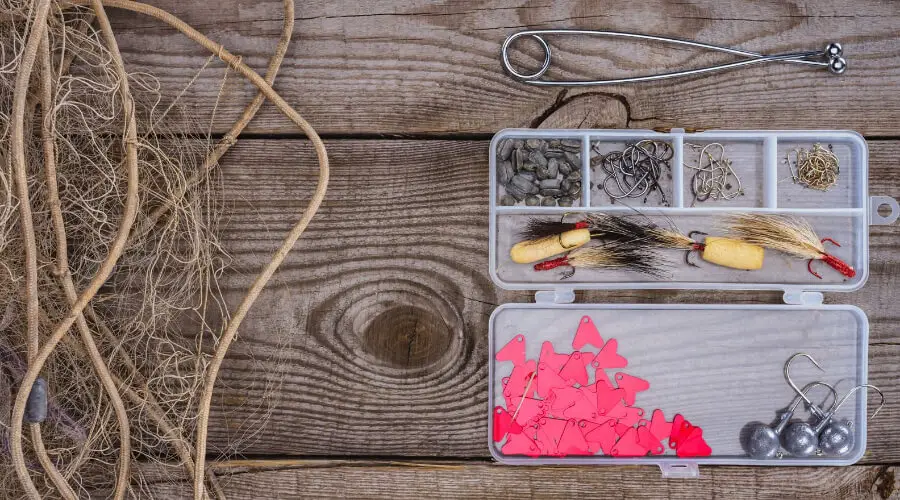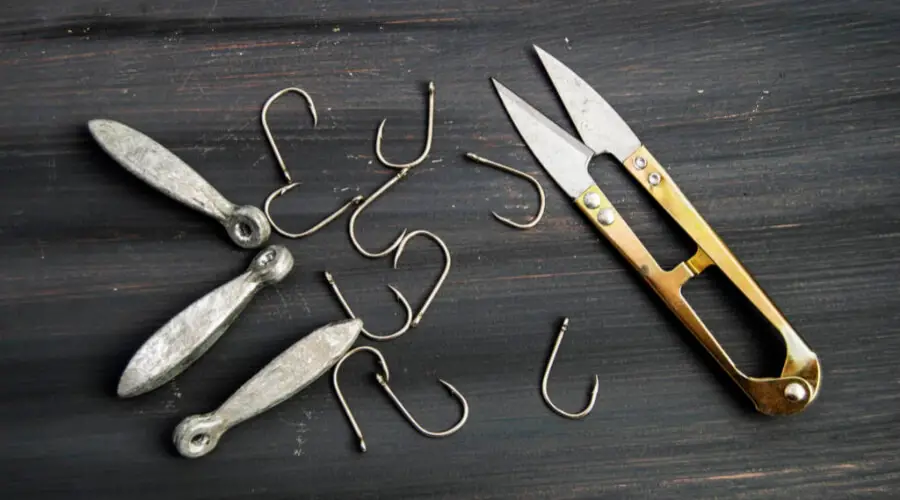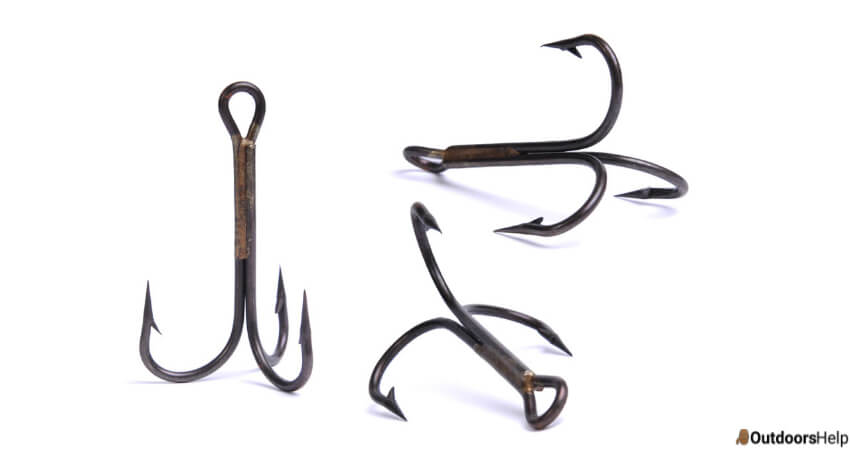Every angler knows how important a fishing hook is to every fishing experience but choosing the right-sized hook is even more important. Fishing hooks come in different types and sizes, and knowing how to differentiate them makes work easier for you. Did you know that there are over 30 different sizes of fishing hooks? This article takes you through the different types of fishing hooks, sizes, and choosing the best hook for any situation. Read on!
Parts Of A Fishing Hook

Before we take you through the different sizes of fishing hooks, it is essential to know the anatomy of a fishing hook. Knowing these parts will make it easier for you to understand the characteristics of different hooks. Let’s dive right into it!
| Part Of A Fishing Hook | Description |
| Eye | The eye resembles a small circle or oval at the top of the hook. It is the point where the line or lure is connected to the hook |
| Point | The point is located at the end of the hook and is the point where the fish’s mouth gets hooked onto |
| Barb | This is a small projection near the point that keeps the fish from unhooking |
| Bend | This refers to the entire curve of the fishing hook |
| Shank | The shank is the relatively straight section between the bend and the eye |
| Gap | The gap refers to the distance between the shank and the point. |
How Are Fishing Hooks Sized?

Choosing the right size of fishing hooks is not as easy as it sounds since no one-size-fits-all guide for hooks. Different fish species will also need different types and sizes of hooks. Let’s look at some terms used to define hook sizes and the different hook sizes you can choose. Later on, we will also look at the different hooks and what each is most suitable for.
1. Whole Number– When choosing a hook size by number, especially when shopping online, you have to know how the sizing is done. The sizing system is done backward, meaning the smaller the number, the larger the hook, and vice versa. This principle applies when the size is a whole number, e.g., hook #2 is larger than hook #4. The largest fishing hook with a whole number is usually size zero.
2. Aught– an aught number is another system used for sizing hooks. In aught system, the size of a fishing hook is indicated as a number, followed by a forward slash then zero. For example, the first number in the aught system is 1\0. In this system, sizing is the opposite of the whole number system in that the larger the number, the larger the hook.
Now that you understand how the hooks are sized, it is essential to find out how many sizes of hooks exist and what each size is suited for. Larger hooks are best for saltwater fishing, while smaller hooks such as size 1 and below are best for freshwater fishing. There are 37 different hook sizes in the market, ranging from size #32, which is the smallest, to size 20/0( pronounced as twenty aughts) being the largest. Below is a sizing chart with the different hook sizes: starting with the largest hook to the smallest. Kindly note that as the size # decreases, the hook gets larger, and when the aught number decreases, the hook gets smaller.
| 20\0 | 19\0 | 18\0 | 17\0 | 16\0 | 15\0 | 14\0 | 13\0 |
| 12\0 | 11\0 | 10\0 | 9\0 | 8\0 | 7\0 | 6\0 | 5\0 |
| 4\0 | 3\0 | 2\0 | 1\0 | 0 | 1 | 2 | 4 |
| 6 | 8 | 10 | 12 | 14 | 16 | 18 | 20 |
| 22 | 24 | 26 | 28 | 30 | 32 |
From the chart above, you can tell that the largest hook is 20 aughts(20\0) while the smallest is #32. However, there are no universal measurements for making a hook. Thus, you may find that size #32 from one brand is smaller than that of the other brand, but the difference is quite insignificant. The hook sizes are meant to guide anglers on what size to expect, especially when buying online.
How To Choose The Right Fishing Hook
Choosing the right hook depends on many factors, including the fish species you are targeting, the size of fish you intend to catch, and whether you are fishing in saltwater or freshwater. In this section, we’ll take you through the key considerations when choosing fishing hooks; keep reading,
1. Type Of Fishing Hook
There are different types and designs of fishing hooks, and each hook is best suited for a specific purpose. Knowing which hook to use where will greatly impact your fishing experience and increase your catch. The different types of fishing hooks are:
a) J-Hooks- these hooks have a straight shank followed by a curve, making them resemble the letter ‘j.’ you need some skills to embed this hook to the fish,
b) Circle Hooks- circle hooks closely resemble j hooks, but they look more of a circle than the letter j. these hooks have a curve pointing further inwards to the shank. For circle hooks, you don’t need to set them since they are designed to rotate in the fish’s mouth and settle in the corner of the jaw.
c) Aberdeen Hooks- these hooks have a wide gap between the shank and the point. They are made of a light and thin wire, making them ideal for live baits. Since they are thin, the bait is hooked easily and without damage, thus keeping baits alive on the hook
d) Bait Hooks– these types of hooks are popular with beginners and children since they are preferred when teaching them how to fish. Bait hooks come in different shape variations and are ideal for catching various fish species and sizes.
e) Offset Shank Hooks- these hooks have an offset shank, as their name suggests. They are mostly used to hold plastic worms to the hook.
f) Octopus Hooks- these hooks do not resemble an octopus and are not used to hook octopus. They have a short and curved shank, sharp point, and barb. They are best for bait fishing when you need a small and lightweight hook.
g) Egg hooks are circular and have a short shank and a wide gap between the shank and the hook’s points. They are ideal for baits like salmon eggs and dough balls.
h) Worm Hooks- worm hooks are large, heavy, and durable since they are intended for aggressive fish such as bass. They are used with plastic worms and penetrate easily into fish and hold them strongly.
i) Siwash Hooks- they are used together with spinnerbaits to catch species such as salmon and steel heads. Their main characteristic is that they have a long and straight shank with a straight eye. These hooks are hard and strong and are used for catching, jumping, and fighting fish species.
j) Weedless Hooks- these hooks are designed with a plastic weed guard that runs from the eye to the point. They are meant for fishing in waters with coverage or vegetation without getting caught in the weeds.
2. Your Fishing Skills
Your level of fishing expertise is a great consideration when choosing fishing hooks. Some hooks require skills to set and catch the fish. If you are a beginner, we recommend starting with bait hooks and keep trying other hooks as you grow your skill. Bait hooks are best for beginners since they can be used with artificial baits, worms, and insects. They are also easy to use, and you don’t require special skills for these types of hooks. Different sizes of bait hooks will require different bait to catch various fish species. The fish species you can catch using bait hooks are panfish, crappie, bass, perch, walleye, and sunfish.
3. Fish Species You Are Targetting
Most fishing hooks are designed with specific fish species in mind. To choose the right hook for every fishing experience, you need to know what species you expect to catch. Every species needs different baits, and different hooks work with different baits. If you intend to catch aggressive species such as bass, you need a strong hook. Always research the best hook for your target species to get the most out of your fishing experience.
Conclusion
Fishing hooks come in different sizes and can be confusing for beginner anglers. Learning how hooks are sized and what each hook is best suited for is essential for every fisherman and angler. After going through this article, we hope you can easily tell which is bigger between size two and size 2/0. Happy angling!

